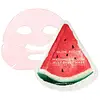What's inside
What's inside
 Key Ingredients
Key Ingredients

 Benefits
Benefits

 Concerns
Concerns

No concerns
 Ingredients Side-by-side
Ingredients Side-by-side

Water
Skin ConditioningGlycyrrhiza Glabra Root Extract
BleachingPaeonia Suffruticosa Root Extract
Skin ProtectingGlycerin
HumectantCitrullus Lanatus Fruit Extract
Skin ConditioningCitrullus Lanatus Fruit Juice
HumectantSodium Hyaluronate
HumectantCentella Asiatica Extract
CleansingPolyglutamic Acid
Skin ConditioningSoy Amino Acids
Skin ConditioningBisabolol
MaskingScutellaria Baicalensis Root Extract
AstringentCeratonia Siliqua Gum
EmollientCyamopsis Tetragonoloba Gum
Emulsion StabilisingBeta-Glucan
Skin ConditioningButylene Glycol
HumectantFructooligosaccharides
HumectantGlycine Soja Sterols
EmollientBrassica Oleracea Capitata Leaf Extract
Skin ConditioningIpomoea Batatas Root Extract
Skin ConditioningXanthan Gum
EmulsifyingDextrin
Absorbent1,2-Hexanediol
Skin ConditioningBenzyl Benzoate
AntimicrobialPhenoxyethanol
PreservativeParfum
MaskingWater, Glycyrrhiza Glabra Root Extract, Paeonia Suffruticosa Root Extract, Glycerin, Citrullus Lanatus Fruit Extract, Citrullus Lanatus Fruit Juice, Sodium Hyaluronate, Centella Asiatica Extract, Polyglutamic Acid, Soy Amino Acids, Bisabolol, Scutellaria Baicalensis Root Extract, Ceratonia Siliqua Gum, Cyamopsis Tetragonoloba Gum, Beta-Glucan, Butylene Glycol, Fructooligosaccharides, Glycine Soja Sterols, Brassica Oleracea Capitata Leaf Extract, Ipomoea Batatas Root Extract, Xanthan Gum, Dextrin, 1,2-Hexanediol, Benzyl Benzoate, Phenoxyethanol, Parfum
Water
Skin ConditioningButylene Glycol
HumectantHydroxyethyl Urea
HumectantGlyceryl Glucoside
HumectantGlycerin
HumectantTrehalose
HumectantBetaine
HumectantErythritol
HumectantSaccharide Isomerate
HumectantAllantoin
Skin ConditioningMethyl Trimethicone
Skin ConditioningHydrolyzed Jojoba Esters
Skin ConditioningSodium Hyaluronate
HumectantEthylhexylglycerin
Skin Conditioning1,2-Hexanediol
Skin ConditioningPolyglyceryl-10 Laurate
Skin ConditioningAcrylates/C10-30 Alkyl Acrylate Crosspolymer
Emulsion StabilisingTromethamine
BufferingDipropylene Glycol
HumectantHydrogenated Lecithin
EmulsifyingGlyceryl Stearate
EmollientCitric Acid
BufferingSodium Phytate
Sodium Citrate
BufferingHydroxyacetophenone
AntioxidantWater, Butylene Glycol, Hydroxyethyl Urea, Glyceryl Glucoside, Glycerin, Trehalose, Betaine, Erythritol, Saccharide Isomerate, Allantoin, Methyl Trimethicone, Hydrolyzed Jojoba Esters, Sodium Hyaluronate, Ethylhexylglycerin, 1,2-Hexanediol, Polyglyceryl-10 Laurate, Acrylates/C10-30 Alkyl Acrylate Crosspolymer, Tromethamine, Dipropylene Glycol, Hydrogenated Lecithin, Glyceryl Stearate, Citric Acid, Sodium Phytate, Sodium Citrate, Hydroxyacetophenone
 Reviews
Reviews

Ingredients Explained
These ingredients are found in both products.
Ingredients higher up in an ingredient list are typically present in a larger amount.
1,2-Hexanediol is a synthetic liquid and another multi-functional powerhouse.
It is a:
- Humectant, drawing moisture into the skin
- Emollient, helping to soften skin
- Solvent, dispersing and stabilizing formulas
- Preservative booster, enhancing the antimicrobial activity of other preservatives
Butylene Glycol (or BG) is used within cosmetic products for a few different reasons:
Overall, Butylene Glycol is a safe and well-rounded ingredient that works well with other ingredients.
Though this ingredient works well with most skin types, some people with sensitive skin may experience a reaction such as allergic rashes, closed comedones, or itchiness.
Learn more about Butylene GlycolGlycerin is already naturally found in your skin. It helps moisturize and protect your skin.
A study from 2016 found glycerin to be more effective as a humectant than AHAs and hyaluronic acid.
As a humectant, it helps the skin stay hydrated by pulling moisture to your skin. The low molecular weight of glycerin allows it to pull moisture into the deeper layers of your skin.
Hydrated skin improves your skin barrier; Your skin barrier helps protect against irritants and bacteria.
Glycerin has also been found to have antimicrobial and antiviral properties. Due to these properties, glycerin is often used in wound and burn treatments.
In cosmetics, glycerin is usually derived from plants such as soybean or palm. However, it can also be sourced from animals, such as tallow or animal fat.
This ingredient is organic, colorless, odorless, and non-toxic.
Glycerin is the name for this ingredient in American English. British English uses Glycerol/Glycerine.
Learn more about GlycerinSodium Hyaluronate is hyaluronic acid's salt form. It is commonly derived from the sodium salt of hyaluronic acid.
Like hyaluronic acid, it is great at holding water and acts as a humectant. This makes it a great skin hydrating ingredient.
Sodium Hyaluronate is naturally occurring in our bodies and is mostly found in eye fluid and joints.
These are some other common types of Hyaluronic Acid:
Learn more about Sodium HyaluronateWater. It's the most common cosmetic ingredient of all. You'll usually see it at the top of ingredient lists, meaning that it makes up the largest part of the product.
So why is it so popular? Water most often acts as a solvent - this means that it helps dissolve other ingredients into the formulation.
You'll also recognize water as that liquid we all need to stay alive. If you see this, drink a glass of water. Stay hydrated!
Learn more about Water